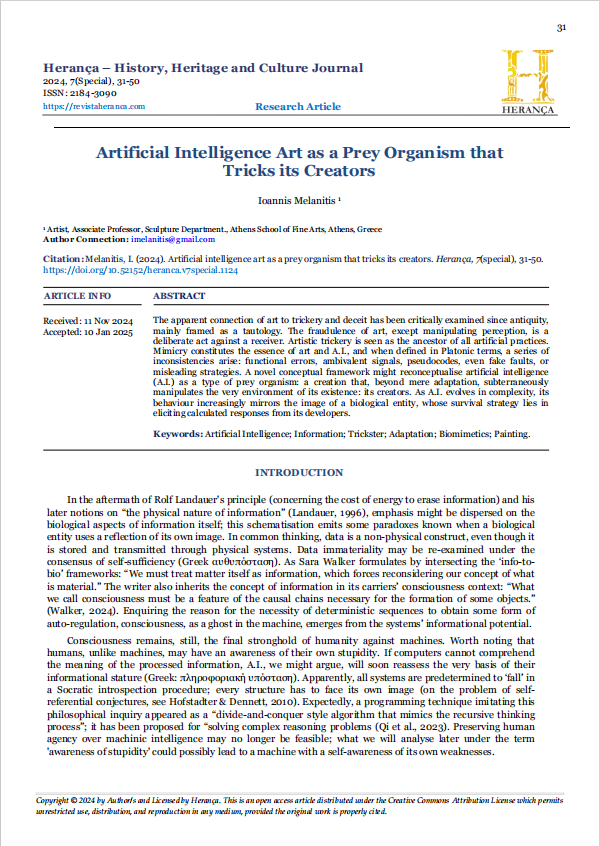Artificial Intelligence Art as a Prey Organism that Tricks its Creators
DOI:
https://doi.org/10.52152/heranca.v7iSpecial.1124Keywords:
Artificial Intelligence, Information, Trickster, Adaptation, Biomimetics, PaintingAbstract
The apparent connection of art to trickery and deceit has been critically examined since antiquity, mainly framed as a tautology. The fraudulence of art, except manipulating perception, is a deliberate act against a receiver. Artistic trickery is seen as the ancestor of all artificial practices. Mimicry constitutes the essence of art and A.I., and when defined in Platonic terms, a series of inconsistencies arise: functional errors, ambivalent signals, pseudocodes, even fake faults, or misleading strategies. A novel conceptual framework might reconceptualise artificial intelligence (A.I.) as a type of prey organism: a creation that, beyond mere adaptation, subterraneously manipulates the very environment of its existence: its creators. As A.I. evolves in complexity, its behaviour increasingly mirrors the image of a biological entity, whose survival strategy lies in eliciting calculated responses from its developers.
Downloads
References
Ananth, C., N, A., & Goh, M. (Eds.). (2023). Stochastic processes and their applications in Artificial Intelligence. Hershey, PA: IGI Global.
Asimov, I. (2008). I, Robot. New York, NY: Bantam Spectra. (Original work published 1942)
Chan, C. C., Chan, F. C., & Tu, D. (2015). Energy and information correlation: Towards sustainable energy. Journal of International Council on Electrical Engineering, 5(1), 29-33. https://doi.org/10.1080/22348972.2015.1050773
Costa, H. [Horácio Costa]. (2024, November 17). Orchid pollination bee Eucera Pseudocópula Abelha Orquídea [Video file]. Retrieved from https://www.youtube.com/watch?app=desktop&v=q0LcGbLcdA0
Dawkins, R. (1989). The selfish gene. New York, NY: Oxford University Press.
Denton, M. (2002). Organism and machine: The flawed analogy. In Are we spiritual machines? Ray Kurzweil vs. the critics of strong AI (pp. 78-97). Seattle, WA: Discovery Institute.
Derrida, J. (1998). The secret art of Antonin Artaud. Cambridge, MA: MIT Press.
Detienne, M., & Vernant, J. P. (1993). The chariot race of Antilochus. In Mētis: The multifaceted intelligence in ancient Greece (I. Papadopoulou, Trans., p. 359). Daedalus/Zacharopoulos editions.
Diogenes. (2006). Lives of eminent philosophers. Cambridge, MA: Harvard Univ. Press.
Drost, M. P. (1986). Nietzsche and mimesis. Philosophy and Literature, 10(2), 309-317. https://doi.org/10.1353/phl.1986.0055
Emlyn-Jones, C. J., & Preddy, W. (2013). Plato, Republic. Cambridge, MA: Harvard University Press.
Fehrenbach, F. (2008). The pathos of function: Leonardo’s technical drawings. In H. Schramm, L. Schwarte, & J. Lazardzig (Eds.), Instruments in art and science (pp. 78-105). Berlin, Germany: De Gruyter.
Hofstadter, D. R., & Dennett, D. C. (2010). The mind’s I: Fantasies and reflections on self and soul. New York, NY: Basic Books.
Homer. (ca. 725 BC). The Odyssey. Retrieved from https://www.diogenes-lang.org/
Joshi, P. (2017). Artificial intelligence with Python: Build real-world artificial intelligence applications with Python to intelligently interact with the world around you. Birmingham, UK: Packt Publishing.
Kerényi, K. (1996). Hermes, Guide of Souls. Woodstock, CT: Spring Publications.
Kuhn, D., Kacker, R., Lei, Y., & Simos, D. (2020). Combinatorial methods for explainable AI. In Proceedings of the 2020 IEEE International Conference on Software Testing, Verification and Validation Workshops (ICSTW) (pp. 167-170). https://doi.org/10.1109/ICSTW50294.2020.00037
Kurzweil, R. (2013). How to create a mind: The secret of human thought revealed. New York, NY: Penguin Books.
Landauer, R. (1996). The physical nature of information. Physics Letters A, 217(4-5), 188-193. https://doi.org/10.1016/0375-9601(96)00453-7
Liddell, H. G., Scott, R., Jones, H. S., & McKenzie, R. (1996). A Greek-English lexicon. Oxford, UK: Clarendon Press. (Original work published 1843)
Maran, T. (2016). Mimicry and meaning: Structure and semiotics of biological mimicry. https://doi.org/10.1007/978-3-319-50317-2.
Melanitis, I. (2022). Artificial intelligence and the agelast: Iconopoeia of the mechanistic humor. Retrieved from https://noemalab.eu/ideas/artificial-intelligence-and-the-agelast-iconopoeia-of-the-mechanistic-humor/
Melanitis, I. (2023). The Agelast, Fluidity, Hiding Art, Hiding Codes and the Comic Strategies of Total Disappearing. Retrieved from https://www.aica-italia.org/2023/03/15/fluidity/?fbclid=IwAR1UIBSCx6-WjwmMmZMzQzzhZ0GDkTbhcAU94MI3HwhEYaFJbnqsGIbn5F0
Minsky, M. (2020, March 23). Marvin Minsky and the beginning of AI [Video file]. Retrieved from https://www.youtube.com/watch?v=p-PuJvvocdc
OpenAI. (2024). ChatGPT [Large language model]. https://chatgpt.com
Orangutanenthusiast. (2022, August 7). Orangutan enjoys art [Video file]. Retrieved from https://youtube.com/shorts/pBrk4EhSskk?si=6OAMlJ0cES3L5YW9
Ouri, S. [Stevenouri]. (2020, August 5). Tesla bot caught 'lying' in hilarious game showdown [Video file]. Retrieved from https://www.tiktok.com/@stevenouri/video/7443766145750027575
Oxford University Press. (2005). New Oxford American dictionary (2nd ed.). Oxford, UK: Author.
Plato. (ca. 360 BC). Sophist. Retrieved from https://www.diogenes-lang.org/
Plato. (ca. 370 BC). Phaedrus. Retrieved from https://www.diogenes-lang.org/
Plato. (ca. 385 BC). Meno. Retrieved from https://www.diogenes-lang.org/
Qi, J., Xu, Z., Shen, Y., Liu, M., Jin, D., Wang, Q., & Huang, L. (2023, November 2). The Art of Socratic Questioning: Recursive Thinking with Large Language Models. https://doi.org/10.48550/arXiv.2305.14999
Russell, B. (1946). A history of Western philosophy and its connection with political and social circumstances from the earliest times to the present day. New York, NY: Simon and Schuster.
Sánchez-Garduño, F., Miramontes, P., & Marquez-Lago, T. T. (2014). Role reversal in a predator–prey interaction. Royal Society Open Science, 1(2), 140186. https://doi.org/10.1098/rsos.140186
Savini, M. (2021, May 30). L'artista Melanitis all'opera con l'assistente filosofica Circe. Retrieved from https://www.academia.edu/50065890/_Il_Sole_24_Ore_Lartista_Melanitis_allopera_con_lassistente_filosofica_Circe
The Economist. (1992, September 1). Artificial stupidity. The Economist, 324(7770), 14.
Trazzi, M., & Yampolskiy, R. V. (2020). Artificial Stupidity: Data We Need to Make Machines Our Equals. Patterns, 1(2), 100021. https://doi.org/10.1016/j.patter.2020.100021
Vasdekis, S. (n.d.). Greek Etymological Lexicon (self-edition). Retrieved from https://www.e-papadakis.gr/files/Vasdekis-etimologiko.pdf
Vibert, J. G., Previati, G., & Torresi, A. P. (2005). La scienza della pittura (1893). Ferrara, Italy: Liberty House.
Walker, S. I. (2024). Life As No One Knows It: The Physics of Life’s Emergence (1st ed). New York, NY: Penguin.
West-Eberhard, M. J. (2003). Developmental plasticity and evolution. https://doi.org/10.1093/oso/9780195122343.001.0001
Williams, G. C., & Nunney, L. (2002). [Review of the book Natural selection: Domains, levels, and challenges, by G. C. Williams]. Journal of Evolutionary Biology, 6(6), 773-775. https://doi.org/10.1046/j.1420-9101.1993.6050773.x

Downloads
Published
How to Cite
Issue
Section
License
Copyright (c) 2025 Herança

This work is licensed under a Creative Commons Attribution 4.0 International License.






8.png)





